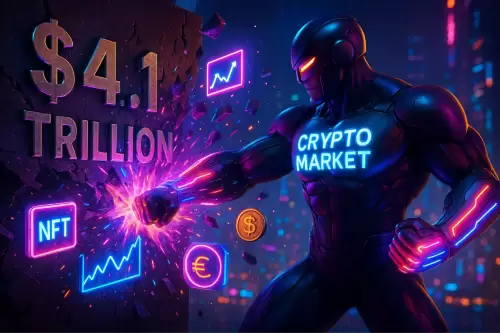 |
|
 |
|
 |
|
 |
|
 |
|
 |
|
 |
|
 |
|
 |
|
 |
|
 |
|
 |
|
 |
|
 |
|
 |
|
Cryptocurrency News Articles
Deep Dive: Understanding the Ratio Between Spot Listings and Delistings on Binance
May 19, 2025 at 01:33 pm
This article analyzes the ratio between tokens listed on the spot market and those delisted from Binance over the past three years, offering key insights for investors.

Binance, the world's largest cryptocurrency exchange, is often considered the “golden stamp” for a token once it gets listed on the spot market. However, in recent months, the rising trend of token delistings from Binance has sparked serious questions about the sustainability of its listing ecosystem.
This analysis examines the ratio between tokens listed on the spot market and those delisted by Binance over the past three years, offering key insights for investors.
Spot Listing vs. Delisting Ratio
According to data compiled from CoinGecko and Dune Analytics, from early 2021 to May 2025, Binance has listed more than 420 tokens on its spot market.
During the same period, nearly 70 tokens were delisted, which amounts to a delisting rate of approximately 16.6%.
To put this in perspective, on average, for every 6 tokens listed, 1 token is delisted within the following 1 to 2 years. This is a notable statistic, especially considering that many investors still view a Binance listing as a mark of safety and credibility.
However, one interesting development is that instead of delisting tokens sporadically, Binance has shifted towards a more cyclical and transparent evaluation process, especially in late 2024 and early 2025.
In these rounds, for every 10-15 tokens listed, a batch of 5-10 tokens was removed at once, signaling that Binance adopts a cluster-based cleanup strategy, especially during market downturns or when its listing standards are tightened.
This model reflects a stricter quality control policy, moving away from relying solely on individual token performance. It aligns with a broader push for improved regulatory compliance and higher project standards in a more mature market environment.
Reasons for Delisting and the Periodic Review Process
Binance applies a stringent assessment procedure before listing any new token. Key criteria include the strength of the development team, liquidity potential, adherence to legal requirements, and the technological value of the project.
These same criteria are periodically applied to re-evaluate listed tokens. If a token no longer meets the required standards, Binance may decide to delist it.
According to Binance Academy and Binance Support, common reasons for delisting include low trading volume, lack of technological progress, regulatory or security issues, and in some cases, delisting is requested by the project team itself.
In addition, Binance has recently introduced a “Community Delisting Vote” mechanism, which allows users to propose the removal of poorly performing tokens from the platform.
Beyond technical and regulatory factors, delisting is also a strategic move to prevent liquidity fragmentation across too many tokens. When a large number of assets are listed, trading volume and capital can become diluted, ultimately reducing market depth and the overall user experience.
By removing underperforming or inactive tokens, Binance can concentrate liquidity on higher-potential assets, such as exchange-backed coins, newly listed tokens, and leading ecosystem projects. This approach enhances trading efficiency and supports the growth of prioritized trading pairs on the platform.
Some Notable Case Studies
One notable case is ALPACA (ALPACA), which was announced for delisting in late Q4 2025. However, the token unexpectedly surged by over 600% shortly after as liquidity reopened on decentralized exchanges (DEXs).
This highlights how “short squeezes” or speculative trading behavior can occur even after negative news, especially when the market senses low liquidity and potential scarcity across other platforms. Nonetheless, this price rally did not reflect any fundamental recovery or long-term value of the token.
Another case that garnered attention was the delisting of MITH (Mithril) in late 2022, which led to a lawsuit against Binance by the project for allegedly lacking transparency in the delisting process.
This signals the potential legal risks exchanges may face if their delisting procedures are not sufficiently clear and disclosed to projects. Ultimately, being listed matters little unless a project stays transparent and keeps engaging its community.
TUSD, a stablecoin previously backed by Binance, was also delisted in March 2024 with its liquidity removed unexpectedly. Even tokens linked to the exchange are subject to delisting if they lack transparency or encounter regulatory issues.
What are the main takeaways?
Binance has listed many tokens tied to trends like GameFi, AI, meme coins, and RWA in the past year. Many tokens have less than $1M in daily volume, indicating poor liquidity and potential for large bid-ask spreads.
Many projects become inactive 3-6 months after listing, increasing their risk of delist if they can’t sustain growth or support.
For example, meme coins like XAI and BOME were listed during waves of social media FOMO. They later saw huge drops in trading volume.
Low updates and a small community increase the chances of delisting if projects fail to deliver lasting value.
GameFi tokens like DAR and TLM now have low activity and weak
Disclaimer:info@kdj.com
The information provided is not trading advice. kdj.com does not assume any responsibility for any investments made based on the information provided in this article. Cryptocurrencies are highly volatile and it is highly recommended that you invest with caution after thorough research!
If you believe that the content used on this website infringes your copyright, please contact us immediately (info@kdj.com) and we will delete it promptly.






























































